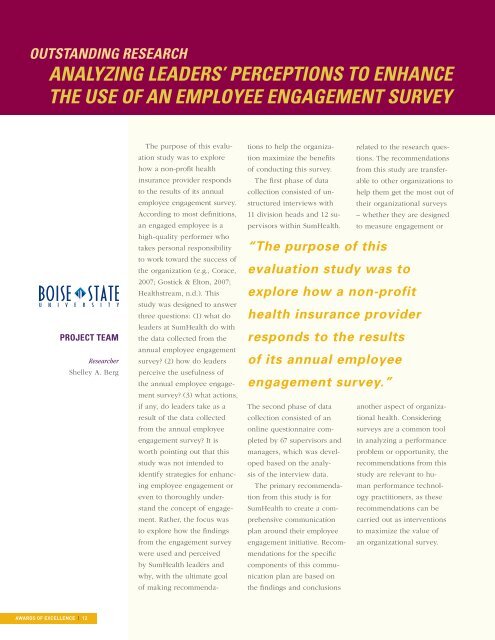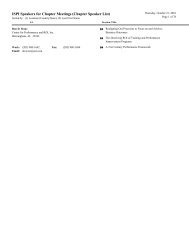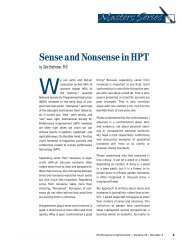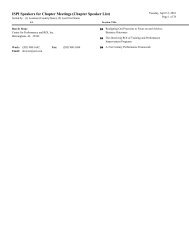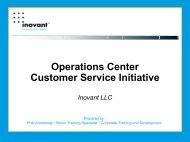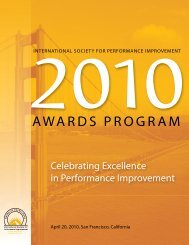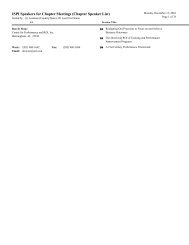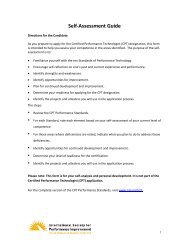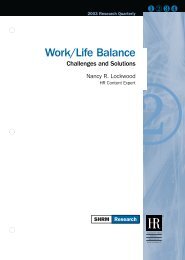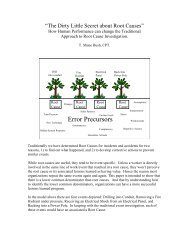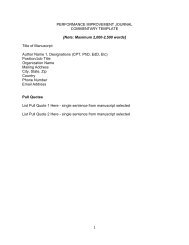CELEBRATING - International Society for Performance Improvement
CELEBRATING - International Society for Performance Improvement
CELEBRATING - International Society for Performance Improvement
Create successful ePaper yourself
Turn your PDF publications into a flip-book with our unique Google optimized e-Paper software.
OUTSTANDING RESEARCH<br />
ANALYZING LEADERS’ PERCEPTIONS TO ENHANCE<br />
THE USE OF AN EMPLOYEE ENGAGEMENT SURVEY<br />
PROJECT TEAM<br />
Researcher<br />
Shelley A. Berg<br />
The purpose of this evaluation<br />
study was to explore<br />
how a non-profit health<br />
insurance provider responds<br />
to the results of its annual<br />
employee engagement survey.<br />
According to most definitions,<br />
an engaged employee is a<br />
high-quality per<strong>for</strong>mer who<br />
takes personal responsibility<br />
to work toward the success of<br />
the organization (e.g., Corace,<br />
2007; Gostick & Elton, 2007;<br />
Healthstream, n.d.). This<br />
study was designed to answer<br />
three questions: (1) what do<br />
leaders at SumHealth do with<br />
the data collected from the<br />
annual employee engagement<br />
survey? (2) how do leaders<br />
perceive the usefulness of<br />
the annual employee engagement<br />
survey? (3) what actions,<br />
if any, do leaders take as a<br />
result of the data collected<br />
from the annual employee<br />
engagement survey? It is<br />
worth pointing out that this<br />
study was not intended to<br />
identify strategies <strong>for</strong> enhancing<br />
employee engagement or<br />
even to thoroughly understand<br />
the concept of engagement.<br />
Rather, the focus was<br />
to explore how the findings<br />
from the engagement survey<br />
were used and perceived<br />
by SumHealth leaders and<br />
why, with the ultimate goal<br />
of making recommendations<br />
to help the organization<br />
maximize the benefits tions. The recommendations<br />
related to the research ques-<br />
of conducting this survey. from this study are transferable<br />
to other organizations to<br />
The first phase of data<br />
collection consisted of unstructured<br />
interviews with their organizational surveys<br />
help them get the most out of<br />
11 division heads and 12 supervisors<br />
within SumHealth. to measure engagement<br />
– whether they are designed<br />
or<br />
“The purpose of this<br />
evaluation study was to<br />
explore how a non-profit<br />
health insurance provider<br />
responds to the results<br />
of its annual employee<br />
engagement survey.”<br />
The second phase of data another aspect of organizational<br />
health. Considering<br />
collection consisted of an<br />
online questionnaire completed<br />
by 67 supervisors and in analyzing a per<strong>for</strong>mance<br />
surveys are a common tool<br />
managers, which was developed<br />
based on the analy-<br />
recommendations from this<br />
problem or opportunity, the<br />
sis of the interview data. study are relevant to human<br />
per<strong>for</strong>mance technol-<br />
The primary recommendation<br />
from this study is <strong>for</strong> ogy practitioners, as these<br />
SumHealth to create a comprehensive<br />
communication carried out as interventions<br />
recommendations can be<br />
plan around their employee to maximize the value of<br />
engagement initiative. Recommendations<br />
<strong>for</strong> the specific<br />
an organizational survey.<br />
components of this communication<br />
plan are based on<br />
the findings and conclusions<br />
AWARDS OF EXCELLENCE | 12


